Guajuvira: Cordia americana
5 posters
Page 1 of 1
 Guajuvira: Cordia americana
Guajuvira: Cordia americana
This is an indigenous tree from my state. It is called Guajuvira (Cordia americana) and i am working with it for a while now, some from cuttings and some from yamadori.
This specimen was collected more than five years ago, it had several problems with inverted conicity, but now i think it is getting on its path.
For now it is in a concrete pot, just for training purpouses.

This specimen was collected more than five years ago, it had several problems with inverted conicity, but now i think it is getting on its path.
For now it is in a concrete pot, just for training purpouses.


Arzivenko- Member
 Re: Guajuvira: Cordia americana
Re: Guajuvira: Cordia americana
with something that low to the ground, i dont believe "inverted conicity" is any problem...
at least not from the angle you provided...
very powerful for a short guy !
at least not from the angle you provided...
very powerful for a short guy !

Kevin S - Wisco Bonsai- Member
 Re: Guajuvira: Cordia americana
Re: Guajuvira: Cordia americana
If you cant see the image, please click on this link: https://goo.gl/photos/5y2V6wk7qsi262Sr9

Arzivenko- Member
 Guajuvira: Cordia americana
Guajuvira: Cordia americana
Thanks for the photo link.Like that a lot.Especially the Shohin size.Because of your post I will be searching for Cordia brevispicata,which grows in Baja California Sur.I swear the world of tropical trees,growing in their own environments,has superseded my interest in the Northern ones.Which is great.I cannot provide that type of dormancy anyway.

geo- Member
 Re: Guajuvira: Cordia americana
Re: Guajuvira: Cordia americana
yeah george... no shortage of tropical trees to choose from - thats for sure !

Kevin S - Wisco Bonsai- Member
 Re: Guajuvira: Cordia americana
Re: Guajuvira: Cordia americana
Nice tree! Do you know the natural range? If it lives in Costa Rica, I want some!,
Geo, Im with you on the tropicals. There are so many and northern trees just dont live here. And for me there overdone. Maples and junipers are nice and all, but seeing something that hasnt been done 1000000 times is kinda hard it seems like. The more I read and look, the more new (to me), the more species I learn about. Its more fun to me seeing strange species than another mugo pine. There cool but common and so over copied that tropicals are more fun. And they arent available here anyway..
This is a cool tree and Id love to see more tropicals. We have sooooo many to choose from, so its nice to know of another that plays along with our type of torture..
Geo, Im with you on the tropicals. There are so many and northern trees just dont live here. And for me there overdone. Maples and junipers are nice and all, but seeing something that hasnt been done 1000000 times is kinda hard it seems like. The more I read and look, the more new (to me), the more species I learn about. Its more fun to me seeing strange species than another mugo pine. There cool but common and so over copied that tropicals are more fun. And they arent available here anyway..
This is a cool tree and Id love to see more tropicals. We have sooooo many to choose from, so its nice to know of another that plays along with our type of torture..

Eric F- Member
 Guajuvira: Cordia americana
Guajuvira: Cordia americana
http://www.tropicos.org/docs/meso/cordiaceae.pdf
In Spanish,Eric,,but I think you speak or,at least, read it:
A rundown of the Mesoamerican species with locations.I am certain that one or more of them can be located in Costa Rica.
George.
In Spanish,Eric,,but I think you speak or,at least, read it:
A rundown of the Mesoamerican species with locations.I am certain that one or more of them can be located in Costa Rica.
George.
Last edited by geo on Fri Feb 26, 2016 4:10 am; edited 1 time in total (Reason for editing : sp and punct.)

geo- Member
 Re: Guajuvira: Cordia americana
Re: Guajuvira: Cordia americana
Gracias George, El Español es facil para mi, yo si leyo, escribo y mas que todo hablo Español muy bien.. Gracias para la link.
Thanks, Yes I read and write spanish and speak it better. Thanks for the link, I will check it out. Thats a good looking tree! Are you familiar with a tree they call poro' that this time of year drops its leaves then has orange flowers then a bean like seed pod? They have thorny trunks if grown from seed. I am going to try to make bonsai out of a couple to see if it works. They are super tough trees but the leaves might be too big. Id like to know if anyone uses it. Its invasive here and I dont know where there from or a latin name for them. There seeding now. They grow fast and put nitrogen in the soil plus make good shade on coffee farms. Also its used as living fence because a branch will root. Im thinking about cutting a thick one to try as bonsai as well as seed.
Thanks, Yes I read and write spanish and speak it better. Thanks for the link, I will check it out. Thats a good looking tree! Are you familiar with a tree they call poro' that this time of year drops its leaves then has orange flowers then a bean like seed pod? They have thorny trunks if grown from seed. I am going to try to make bonsai out of a couple to see if it works. They are super tough trees but the leaves might be too big. Id like to know if anyone uses it. Its invasive here and I dont know where there from or a latin name for them. There seeding now. They grow fast and put nitrogen in the soil plus make good shade on coffee farms. Also its used as living fence because a branch will root. Im thinking about cutting a thick one to try as bonsai as well as seed.

Eric F- Member
 Re: Guajuvira: Cordia americana
Re: Guajuvira: Cordia americana
Que problema! My phone wont open the link! Thats par for the course hear...

Eric F- Member
 Guajuvira: Cordia americana
Guajuvira: Cordia americana
Eric;
Your 'Poro' is Erythina poeppigiana. In Columbia they are shoving sticks in the ground and harvesting the leaves for forage.So,yes,great cutting possibilities.As to the seeds-poisonous!
The Baja 'Colorin' is E. flabelliformis.A smaller tree,similar great scarlet blooms and probably roots well too.Try them.Nothing to lose.
Your 'Poro' is Erythina poeppigiana. In Columbia they are shoving sticks in the ground and harvesting the leaves for forage.So,yes,great cutting possibilities.As to the seeds-poisonous!
The Baja 'Colorin' is E. flabelliformis.A smaller tree,similar great scarlet blooms and probably roots well too.Try them.Nothing to lose.

geo- Member
 Re: Guajuvira: Cordia americana
Re: Guajuvira: Cordia americana
Eric F wrote:Gracias George, El Español es facil para mi, yo si leyo, escribo y mas que todo hablo Español muy bien.. Gracias para la link.
Thanks, Yes I read and write spanish and speak it better. Thanks for the link, I will check it out. Thats a good looking tree! Are you familiar with a tree they call poro' that this time of year drops its leaves then has orange flowers then a bean like seed pod? They have thorny trunks if grown from seed. I am going to try to make bonsai out of a couple to see if it works. They are super tough trees but the leaves might be too big. Id like to know if anyone uses it. Its invasive here and I dont know where there from or a latin name for them. There seeding now. They grow fast and put nitrogen in the soil plus make good shade on coffee farms. Also its used as living fence because a branch will root. Im thinking about cutting a thick one to try as bonsai as well as seed.
Hi Eric
I glanced at the link. It is a pdf, if you are using an Android phone, check your downloads, your phone probably downloaded rather than opened the link. File->downloads-> Cordiaceae
The download part that is about Corida is a botanical key, the ''official'' way to separate the different species of Cordia, and the genus Varronia, which is closely related. I don't read Spanish, but I do read "Botanical Latin", at least well enough to guess at the contents. Good info for sorting out which of the group you are looking at. The second part after the key for Cordia and Varronia are individual species descriptions, listing native ranges, read that part first, use the keys when trying to sort out which specimen you have in front of you.
As I mentioned before if you are interested in your local native flora, trees, shrubs, and plants in general a great resource is the Lankester Gardens, there in Costa Rica. In another thread I had posted their address and website. PM me if you can't find the old post.
In terms of evaluating local trees for possible usefulness as bonsai, there are some traits you can look for, some traits are good, some are traits to avoid.
Compound leaves - generally a species with compound leaves will not make a ''good'' bonsai, the more leaflets a compound leaf has the more likely it will be a bad choice for bonsai. This knocks out most trees in the legume and acacia families, When the compound leaves are short, with relatively few leaflets, sometimes these work. IF the tree has a trait that is outstanding, such a great flowers or really rough bark, they might be useful especially if they bloom while leafless. They will become like Wisteria, shown in flower then hidden in the back of the garden the rest of the year.
Alternate leaf pattern - this is the easiest pattern of leaf production for creating a nice looking bonsai. A good trait to look for. Best if coupled with simple leaves, of smaller size.
Leaf size, obviously the smaller the better, but in general leaf reduction will happen as ramification develops. Defoliation can bring down leaf size. For most species leaves usually can be shrunk to 1/4 to 1/10th size without too much trouble. There are exceptions. And some reduce more dramatically, for example ficus.
In Central America there are several native species of Diospyros - the genus of persimmons and ebony. All the diospyros I know of are pretty good as bonsai. When the leaves are large, they will reduce as branch ramification increases. Up north the temperate species hold their fruit after leaves drop in autumn, which is when they are usually displayed. The evergreen Diospyros you will have to work on leaf reduction techniques to get smaller leaves. They have very hard wood, and hold shape well if branches are wired while flexible and they do bud back well enough that hard pruning will be tolerated if not too frequent. Fruit of most is edible, some more than others. A few are not edible.
Rough bark - look for species with rough bark, especially if it develops on younger trees.
The myrtle family includes Eugenia, Jaboticaba and Guava, look for species with smaller leaves and shrubby habit. Nice flowers and edible fruit.
Gmelina is a genus used for bonsai, there are several species native to Costa Rica.
Ficus, don't ignore your local native ficus. The asian ficus are the workhorse of tropical bonsai in much of the world, but there is a whole array of native Central American ficus, scout along stream banks and see if you can find some. They tend to be lowland species, flood plains and near streambanks are good scouting areas. Leaf reduction techniques work very well on almost all members of ficus. If a leaf 1/20th the size of the leaf you see in the wild is small enough for bonsai, you are probably looking at a good candidate for bonsai if it is a ficus. Some the leaves can be reduced to 1/50th of original size. Lots of info out there on growing Ficus as bonsai. Look to your local ''Strangler Figs"'.
I could go on, but that was what just leaped to mind. Look for simple, alternate leaf patterns, interesting bark, flowers or fruit, and smaller leaves if possible. Get yourself a tree guide to Costa Rican trees. Learn about your local flora. You may discover the ''Next Great Topical Bonsai"" species. Explore.

Leo Schordje- Member
 Re: Guajuvira: Cordia americana
Re: Guajuvira: Cordia americana
Hello friends, thanks you for the commentary. I agree with you, we have to search for our own bonsai species, or die making bad japanese bonsai copies.
Leo your text is very useful, i have already though about a lot of what you said. I´m with you!
Leo your text is very useful, i have already though about a lot of what you said. I´m with you!

Arzivenko- Member
 Re: Guajuvira: Cordia americana
Re: Guajuvira: Cordia americana
Friends, today I decided to organize my files and retrieve some information that went through scattered. In this way I will present the history of this plant a Guajuvira - Patagonula americana. This is an indigenous species from south Brazil, wich i like very much to work , its a perenial tree with dense foliage. The first record I have of her is 2010, at the peak of my interest in bonsai (the first time I read something was in August 2008). In this period i was suported and helped by my great friend and tutor Afonso Fengler, who gave me this plant because it had roots out of the middle of the trunk, impossible to fix.
March 2010: As soon as the plan was to stop in my old house (temporary), was rather neglected and without intervention.
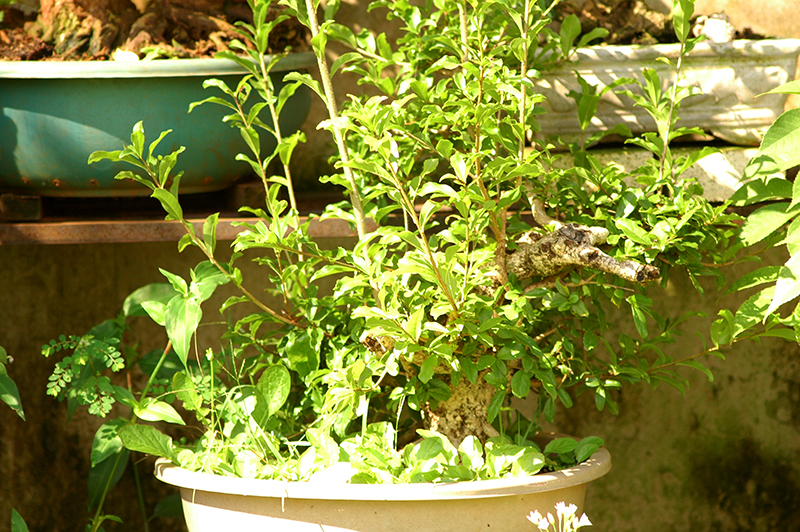
November 2010: defoliation, pruning, selection of branches and wiring. Notice the inverted taper and the adventitious roots.

2011-2013: black period, which i remained two years completely neglecting my bonsai.
June 2013: In my residence, I rescue the surviving plants, this Guajuvira was one of it.
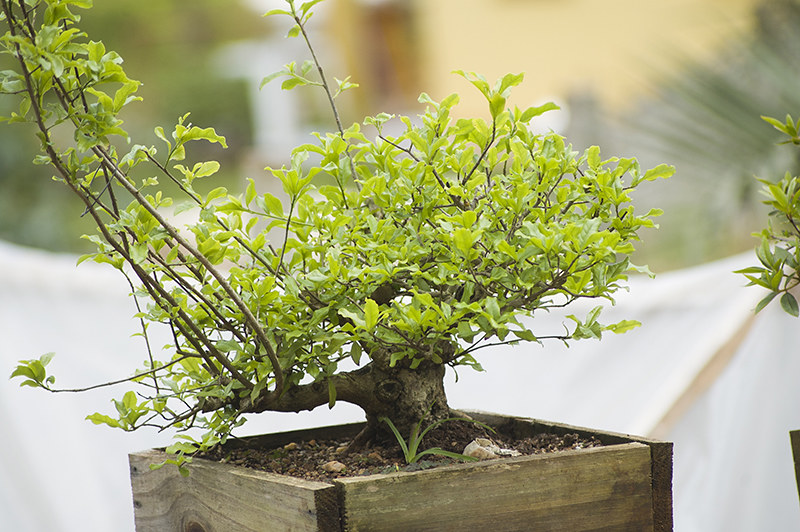
March 2014: Just keeping the sacrifice branches on the lower part of the tree, thinner than it should.
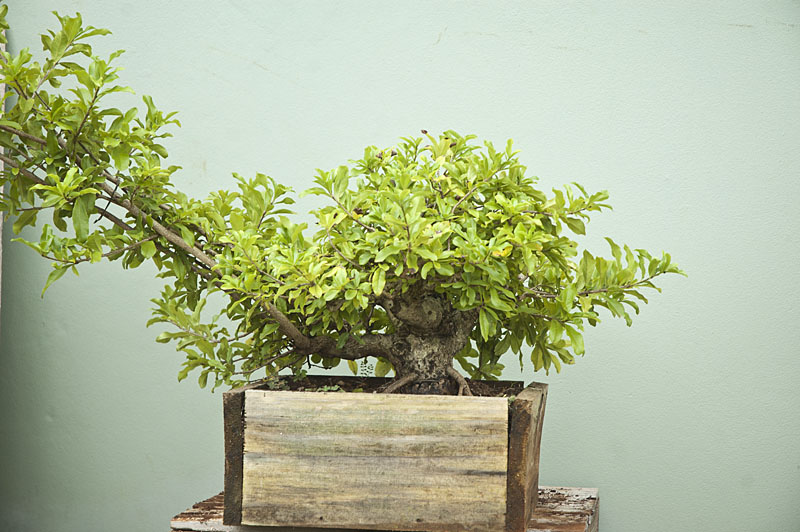
February 2016: After complete restyling.
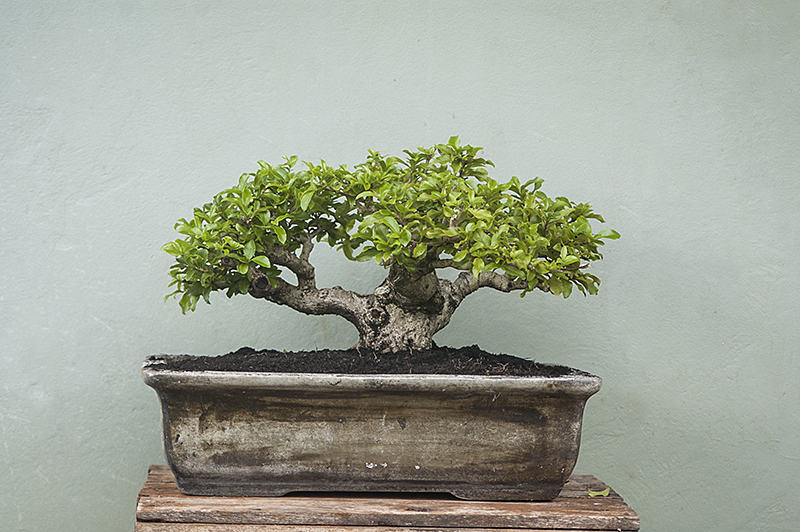
August 2016: New training pot and spring defoliation.
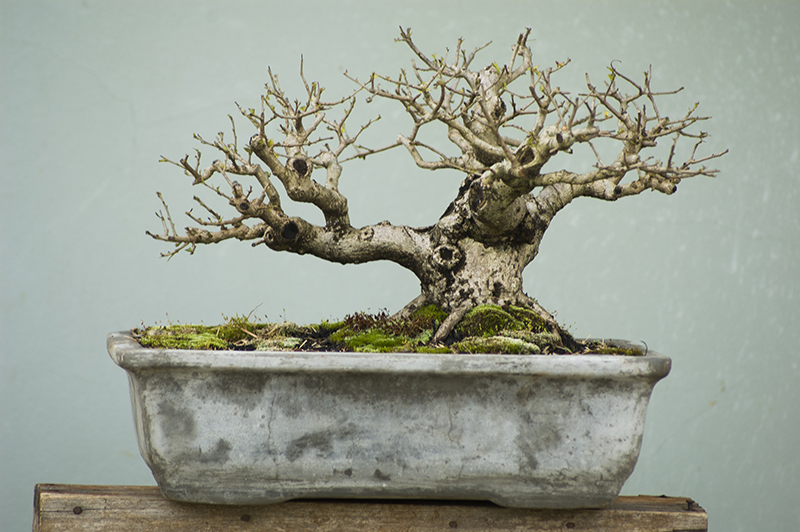
March 2010: As soon as the plan was to stop in my old house (temporary), was rather neglected and without intervention.

November 2010: defoliation, pruning, selection of branches and wiring. Notice the inverted taper and the adventitious roots.

2011-2013: black period, which i remained two years completely neglecting my bonsai.
June 2013: In my residence, I rescue the surviving plants, this Guajuvira was one of it.

March 2014: Just keeping the sacrifice branches on the lower part of the tree, thinner than it should.

February 2016: After complete restyling.

August 2016: New training pot and spring defoliation.


Arzivenko- Member
Page 1 of 1
Permissions in this forum:
You cannot reply to topics in this forum






